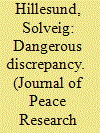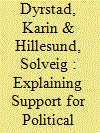| Srl | Item |
| 1 |
ID:
164163


|
|
|
|
|
| Summary/Abstract |
Do different types of inequality spur violence with different targets? This article explores whom violent movements choose to target when they take to arms, by comparing civil conflicts, which target the state, to communal conflicts, which target other ethnic groups. Different types of ethnic group disadvantage relate to conflict through different mechanisms. Political exclusion is expected to promote the choice to target the central government rather than other ethnic groups, while economic disadvantages should increase the risk of both civil and communal conflicts. The different expectations stem from two important differences between political and economic horizontal inequalities: only the government has the authority to change the political distribution, while there can be many avenues to economic redistribution; and blame is more straightforwardly assigned to the government for political than for economic disadvantages. Statistical analysis of 155 politically relevant ethnic groups in Africa (1991–2009) provides support for both propositions.
|
|
|
|
|
|
|
|
|
|
|
|
|
|
|
|
| 2 |
ID:
137028


|
|
|
|
|
| Summary/Abstract |
This study aims to uncover how horizontal inequality affects support for violent and nonviolent resistance among Palestinians in the West Bank and Gaza. National survey data are introduced to operationalize the mechanisms proposed in the horizontal inequality literature on the individual level. Results point to the operation of political and economic horizontal inequality mechanisms in the Palestinian case. Higher perceived status of civil and political rights is associated with a lower probability of supporting violent over nonviolent resistance. Individuals are also more likely to support violent over nonviolent resistance the larger the difference in household expenditure and consumer durable ownership between their own region and the closest Israeli subdistrict. Corresponding differences in educational attainment have no corresponding effect. The results demonstrate how economic and political horizontal inequality can increase the risk that an individual becomes part of the mobilizational potential of violent social movements. This can lead to participation in a wide range of supportive actions that increase the viability of such movements, ranging from material support to direct participation in violence. The level of public support for violent resistance in key constituencies could also influence public opinion sensitive actors like Hamas in their choice between violent and nonviolent resistance strategies.
|
|
|
|
|
|
|
|
|
|
|
|
|
|
|
|
| 3 |
ID:
175337


|
|
|
|
|
| Summary/Abstract |
What explains support for violence against the state? The surge in survey-based studies in (former) conflict areas has improved our understanding of the determinants of armed conflict. Yet, the potential interaction between grievances and political opportunity structure has received little attention in microlevel studies. Integrating common arguments from the civil war literature with the political behavior tradition, this article argues that perceived political efficacy, a central component of the political opportunity structure, moderates the association between individual and group grievance and people’s support for political violence. It represents a first individual-level test of the argument that perceived political opportunity structure and grievances combine to explain internal armed conflict. Using original survey data from Guatemala, Nepal, and Northern Ireland (2016), we find robust empirical evidence that support for violence increases with perceived grievance and decreases with political efficacy; and some evidence of an interaction between the two.
|
|
|
|
|
|
|
|
|
|
|
|
|
|
|
|